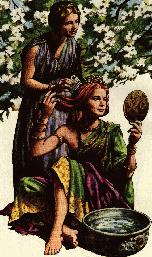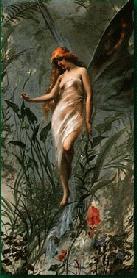

|
|
Many are still said to be the guardians of
certain Irish clans.
Three miles south west of Lough Gur is Cnoc Aine, or Knockainy, the hill of Aine, one of the most important fairy queens of Munster. Also on the shores of the lake is Cnoc Finnine, of the goddess Fennel, the sister of Aine.
Many of the sidhe folk have encounters or relationships
with mortals. The Earl of Desmond once saw  Aine
combing her hair on the bank of a river. He fell in love with her and seizing
her cloak made her his wife. The offspring
of this union was Aine's enchanted son Geroid Iarla, who lives under the
lake awaiting his return to the world of men. Once every seven years he
emerges from the water as a phantom riding on a white horse.
Aine
combing her hair on the bank of a river. He fell in love with her and seizing
her cloak made her his wife. The offspring
of this union was Aine's enchanted son Geroid Iarla, who lives under the
lake awaiting his return to the world of men. Once every seven years he
emerges from the water as a phantom riding on a white horse.
Aine is revered throughout Ireland. In Co. Derry locals say she was a mortal woman who was 'taken' by the fairies; the local family O'Corra are said to be descended from Aine. In Co. Louth Aine's stronghold is at Dunany point (Dun Aine). Every year three days are dedicated to her, the first Friday, Saturday and Sunday after Lammas; it was said that she would claim a life on those days.
It is at Cnoc Aine in Co. Limerick where Aine is most well remembered as a great queen. Every year on St. John's Eve (24 June) local people would form a procession around the hill, then carry flaming torches through the fields of ripening crops. Aine herself was seen on many occasions leading the procession.
![]()
The fairy queen of the north of Munster is Aoibheal;
she is the ancestral deity of the O'Briens, (the descendants of Brian Boru)
who rules from Craig Liath (grey rock) in Co. Clare. At the great battle
of  Clontarf,
Aoibheal had fore-knowledge of the outcome and tried to warn her people.
Aoibheal is revered in many of the 'Aislings', the vision poems of the
eighteenth century concerning the future freedom of Ireland.
Clontarf,
Aoibheal had fore-knowledge of the outcome and tried to warn her people.
Aoibheal is revered in many of the 'Aislings', the vision poems of the
eighteenth century concerning the future freedom of Ireland.
Cliodna is loved and cherished by the people of
Co. Cork, where a number of place names are associated with her. She is
the guardian goddess of the O'Keefes, and said to be the eldest daughter
of the last Druid of Ireland. One of the three great waves mentioned in
Irish mythology is Tonn Cliodna, the wave of  Cliodna,
off the coast at Glandore, Co. Cork. A legend tells of Ciabhan of the Curling
Locks who took Cliodna out of the lands of Manannan and brought her to
the shores of Ireland in his curragh. He left Cliodna alone on the shore
while he went off to hunt deer; while he was gone Manannan sent a huge
wave over the strand and Cliodna was drowned.
Cliodna,
off the coast at Glandore, Co. Cork. A legend tells of Ciabhan of the Curling
Locks who took Cliodna out of the lands of Manannan and brought her to
the shores of Ireland in his curragh. He left Cliodna alone on the shore
while he went off to hunt deer; while he was gone Manannan sent a huge
wave over the strand and Cliodna was drowned.
![]()
In the north east of Leinster the fairy queen Grian of the Bright Cheeks has her abode on Cnoc Greine. The sidhe mound of her father was attacked once by the five sons of Conall. Grian pursued them and in revenge she transformed them into badgers. In the Irish sagas Grania eloped with Diarmaid, and all over Ireland there are cairns and cromlechs known locally as 'the bed of Diarmaid and Grania'. In Co. Tipperary, east of loch Derg, lies Knockshegouna, the fairy hill of Una. Una is the wife of the fairy king Finnbheara of Cnoc Meadha; she is a somewhat elusive figure, but nevertheless her sidhe dwelling was a very important place in former times, and she is still remembered by local people.
![]()